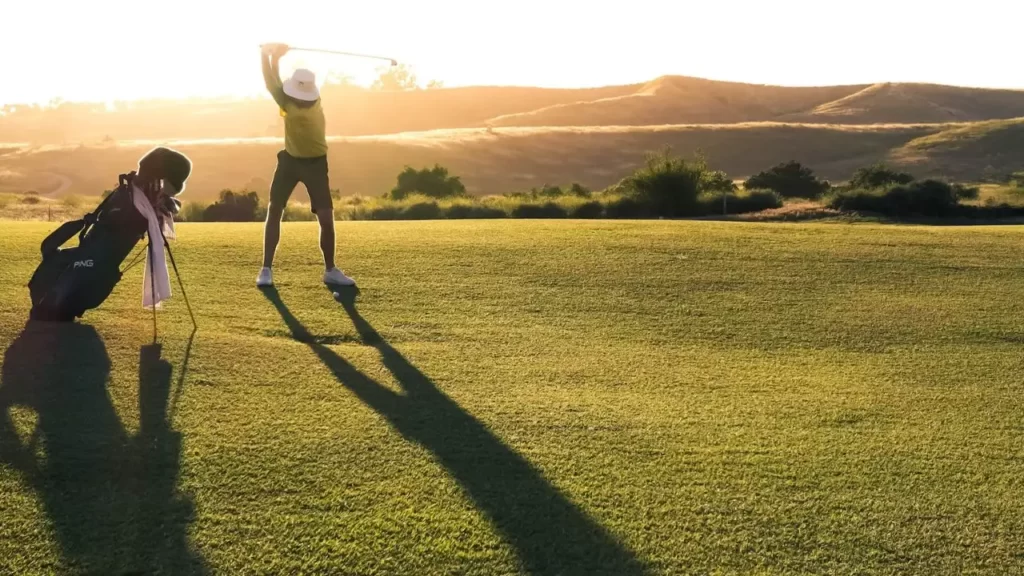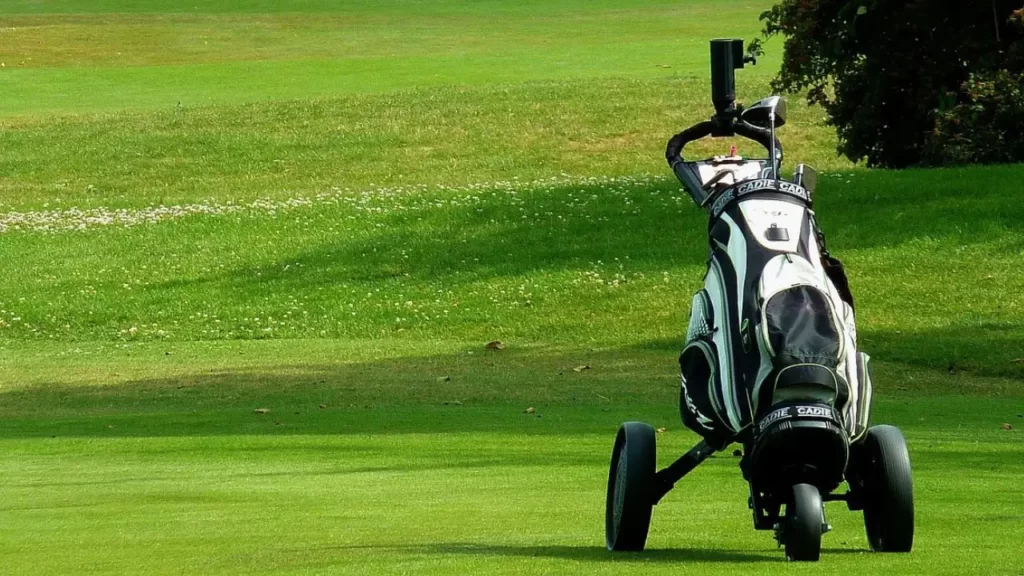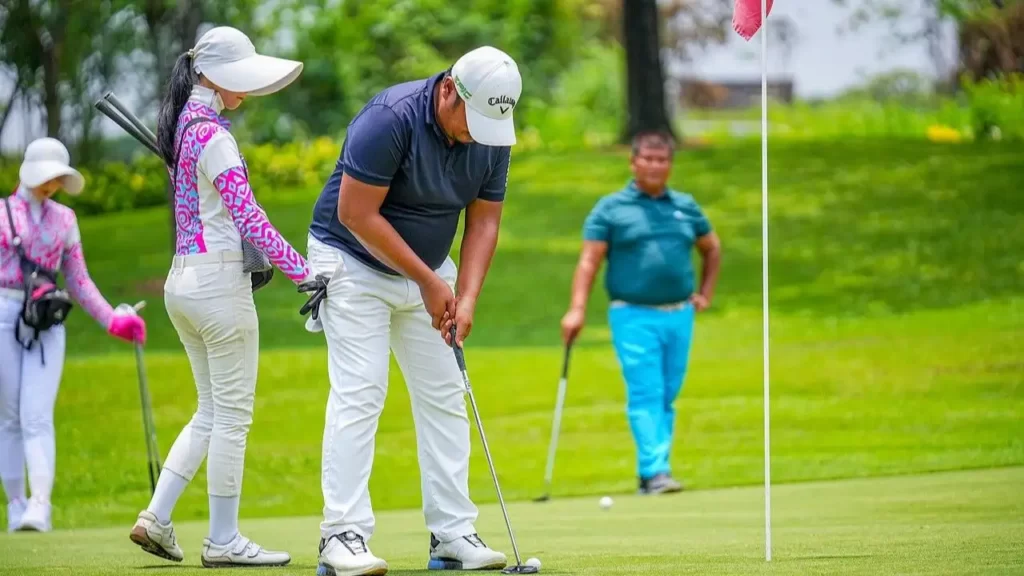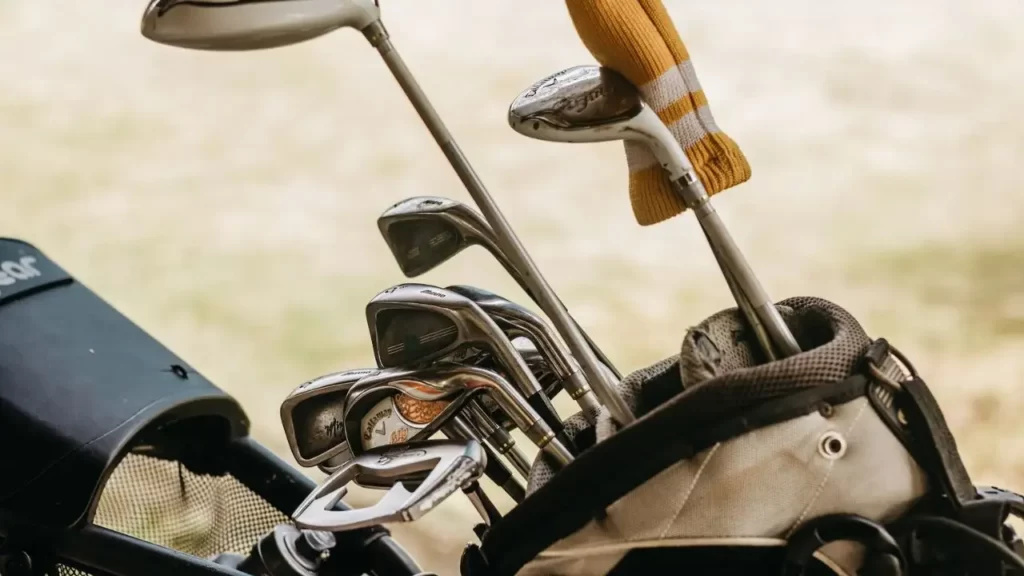What Is a Golf Caddy: Their Purpose and Benefits for Golfers
- Last updated on August 16, 2023
- Toni Benedito
- Golf Courses, Blog
A golf caddy is an indispensable ally on the course, carrying a golfer’s clubs, assisting with strategy and club selection, and providing advice on course obstacles and rules. Offering a close-up view of the game, being a caddy can be a rewarding experience, with many becoming recognized figures in the sport. While responsibilities vary, typical duties include tending flagsticks, raking bunkers, and replacing divots.

Key Takeaways
- Golf caddies are more than just equipment carriers; they provide strategic advice, assistance, and emotional support to players throughout the game.
- Caddies assist with club selection, strategy, yardage, and provide insights on course obstacles and scoring rules, making them indispensable companions on the course.
- Successful caddies possess physical fitness for carrying clubs, emotional support abilities, and knowledge of golf terminology. They contribute to maintaining the course and offering advice on playing techniques.
- Aspiring caddies can find opportunities at local golf courses, prepare resumes, and undergo training. Training covers club handling, reading greens, and effective communication with players.
- The caddy role has evolved from carrying clubs to encompass course management, advice, and emotional guidance. While technology advances, the human element remains vital, making caddies an enduring part of the golfing experience.
Introduction
When you watch professional golfers on television or in person, you will often see a person walking alongside them carrying a large bag of golf clubs. This person is called a golf caddy, and they play an essential role in the game. A golf caddy is not just someone who carries a golfer’s clubs from hole to hole.
They are also responsible for providing assistance and support to the golfer throughout the game. The caddy is there to help with club selection, strategy, and yardage.
They are also a source of advice on scoring rules and any potential obstacles on the course. Being a caddie can be an incredibly pleasurable experience for both the player and the caddie.
Caddies get to enjoy the game of golf up close and personal while offering valuable support to their golfer. Many famous caddies have become household names due to their close relationships with players such as James Anderson, Jim Mackay, and Justin Thomas.
"Golf caddies provide indispensable assistance, offering club selection advice, strategic insights, and course guidance. Their presence enhances the game, making a significant impact on player performance."
The responsibilities of a golf caddy can vary from player to player, but some general duties remain consistent across all games. These include carrying the golfer’s bag of clubs, raking bunkers, replacing divots, and tending flagsticks, among other things.
Enjoying this article? Read more:
Check out this video below from mgagolf‘s Youtube channel:
Caddy training has evolved into an industry in itself, with many professional organizations offering courses on how to become a successful caddy girl or boy. It is important for anyone interested in being a caddie to learn about club selection strategies as well as proper communication techniques between themselves and their golfer.
In terms of compensation, salaries for golf caddies can vary widely depending on factors such as location and experience level. A good rule of thumb is that experienced, top-tier professionals make significantly more money than inexperienced amateurs starting out.
Overall, having a good golf caddy can make all the difference in your game by providing valuable assistance and support. With the right training and experience, being a caddy can be an incredibly rewarding career in the world of golf.

The Role of a Golf Caddy
When you think of golf, you may picture a player with a bag full of clubs, ready to hit the ball on the green. But did you know that behind every great golfer is a highly skilled caddy?
A golf caddy plays an essential role in the game, providing strategic advice and support to help their player navigate the course and achieve their goals. It all varies depending on the level of play and expertise of both the golfer and caddy.
At its core, however, a caddy’s main job is to assist and advise their player throughout the round. This includes carrying their bag of golf supplies, offering yardages and hole descriptions to help them determine which club to use for each shot, and reading ground conditions and hazards along the way.
For professional caddies working at top-level tournaments or for experienced players at country clubs, there are several additional responsibilities that come with being a caddie. These can include helping with divot repair and keeping track of scores according to rules set by golf associations like James Anderson’s or Angelo Argea’s scoring rules.
"Beyond the green, a skilled golf caddy provides strategic advice, club selection insights, and emotional encouragement—critical elements for player success on the course."
They must also be knowledgeable about common golf terms so they can communicate effectively with their players. Caddies also have an essential role in providing emotional support during a round.
Golf can be an extremely mental game, so having someone who understands your strengths and weaknesses can be incredibly helpful in keeping you focused on achieving your goals. Whether it’s reminding you to stay positive after missing an important shot or celebrating your successes along the way,
While being a caddy may not always be glamorous work, especially when they aren’t making top-dollar salaries, it is undoubtedly rewarding for those who are passionate about golfing careers. Caddy training programs exist across many countries for those interested in pursuing this career path. Professional certifications such as PGA programs offer specialized training specifically for aspiring caddies looking to make it big in their field.
Enjoying this article? Read more:

The Skills Required to be a Golf Caddy
Being a golf caddy is no easy feat; it requires a specific set of skills to help the player perform at their best. One of the essential skills for a caddy is being able to carry around equipment throughout the entire course, sometimes for up to 5 hours. A golf bag can weigh up to 20–30 pounds, and pushing an electric caddy or hand trolley with those weights can be physically demanding.
Caddies must be in good shape and prepared for the task at hand. Another essential skill required of a great caddie is emotional support.
Golf can be mentally challenging, and players may experience highs and lows throughout their game. A great caddy will provide encouragement when needed, remain positive during rough patches, and keep players’ spirits high even when things are not going according to plan.
A caddy’s duties go beyond carrying clubs and giving emotional support; they also have responsibilities such as divot repair, raking bunkers, checking yardages, reading greens, and keeping track of scores and penalties from hazards. Some amateur golfers prefer having someone who can provide them with tips on playing various holes or correcting their swing technique; this is where being a source of advice comes in handy.
"Beyond clubs, a caddy's role demands physical stamina to carry heavy equipment and emotional prowess to provide unwavering support during the highs and lows of a game, making them indispensable partners on the green."
One famous example of an excellent caddie is Steve Williams, Tiger Woods’s former caddie, who was known for his unwavering support and dedication to his job. Williams was responsible for carrying Tiger’s equipment but also acted as his emotional support during tournaments.
He was a crucial part of Tiger’s success for many years. While it may seem like carrying around equipment doesn’t require too much skill or effort, being a great caddie requires more than just physical strength.
It takes someone with good communication skills who understands how to provide emotional support while fulfilling all the responsibilities that come with the role. Being a golf caddy also provides pleasurable experiences on some beautiful courses worldwide; it’s not just a job but can be a career for someone who has the passion and dedication to do it right.

How to Become a Golf Caddy
So, you want to become a golf caddy? Well, it’s not as easy as it sounds. Being a caddy requires specific skills and knowledge of the game of golf.
Here are some tips on how to become a golf caddy. The first thing you need to do is find out if there are any caddy jobs available in your area.
You can start by checking with local golf courses and clubs, especially public golf courses where the demand for caddies may be higher. You can also search online for caddy jobs in your area.
Once you have found a potential job opening, you will need to prepare your resume and cover letter to apply for the position. Ensure that your resume highlights any relevant experience that showcases your knowledge of golf and your ability to carry golf clubs, give accurate hole descriptions, assist with scoring rules, and help rake bunkers.
Next up is getting trained as a caddie. Most courses will require you to complete some form of training before being hired as a caddie.
"The path to caddy excellence demands more than meets the eye. From finding opportunities and crafting a compelling resume to mastering golf nuances and learning from seasoned pros, the journey is a dedicated pursuit toward an invaluable role in the sport."
This might include learning how to carry clubs properly, how to read greens accurately, or even some general knowledge about different equipment used in the game. At this point, it is important that you become familiar with the different types of clubs used by players and their individual uses during play so that when asked for advice on which club to use in specific situations, you are able to provide reliable information.
Enjoying this article? Read more:
Check out this video below from Insider Business‘s Youtube channel:
Once hired as an assistant or junior caddy, pay attention during training sessions given by experienced senior caddies or pro players like Jim Mackay or Steve Williams, who have been known for their successful careers working with renowned professional golfers Phil Mickelson and Tiger Woods, among others. These senior pros will teach basics such as how to spot tee shots off the tee box while keeping track of wind conditions so players can make informed decisions when playing through each hole.
Becoming a golf caddy requires a lot of hard work and dedication. It may not be glamorous, but it is an indispensable role in the game of golf. With the right training and experience, you could become one of the famous caddies someday!
Enjoying this article? Read more:

The Evolution of the Golf Caddy Role
As golf has evolved through the years, so too has the role of the caddy. Historically, caddies were simply hired to carry a golfer’s clubs and walk alongside them during a round.
Over time, however, their duties have expanded to include various tasks that make for a pleasurable experience on the course. One important evolution in golf caddying was the introduction of rented caddies.
In earlier days, players would have to bring their own caddies or rely on locals who were familiar with the course to carry their clubs. But as golf grew in popularity and more people began playing on unfamiliar courses, rented caddies became more common.
These individuals were often experienced local players who could offer advice on ground conditions and strategies for playing each hole. In addition to carrying golf clubs and offering strategic advice, modern-day caddies also play a crucial role in maintaining the course itself.
This includes tasks such as bunker raking and filling divots with sand or seed mixtures. Some courses even employ specialized “caddy girls ,whose job it is to provide refreshments and help keep players comfortable during their rounds.
Perhaps one of the most important roles that a modern-day golf caddy serves is that of a spotter for tee shots. With advancements like GPS technology and detailed hole descriptions now available, it may seem like spotting tee shots has become less important over time.
"From club carriers to course companions, the role of golf caddies has transformed over time. Modern caddies provide strategic insights, maintain the course, and serve as essential spotters, ensuring their unwavering significance in the game's dynamic landscape."
However, there are still many situations where having an experienced pair of eyes can be critical, especially when playing in difficult weather conditions or trying to navigate tricky hazards like water hazards or sand traps. Overall, while some may view carrying golf clubs as an outdated job thanks to electric caddy options now available in some places, there’s no denying that being a golf caddy is just as important today as it was decades ago, if not more so!
From providing expert advice on course conditions and strategy to ensuring a pleasurable experience for players, caddies remain an integral part of the game of golf. Just ask notable figures in the sport like Angelo Argea or Tiger Woods’ caddie, who both credit their caddies with helping them enjoy the game and play at their highest level.

Famous Golf Caddies and Their Impact
It’s not uncommon for golf fans to know the name of a golfer’s caddie right along with their favorite player. That’s because famous caddies have made a huge impact on the game of golf by providing emotional support, course knowledge, and crucial tips to golfers.
One of the most famous caddies in recent history is Steve Williams. Williams was Tiger Woods’ longtime caddy and was an essential part of his success during his prime years. In addition to being an excellent guide on the course, Williams also provided emotional support to Woods during his father’s illness and passing. This shows how important a caddy can be, not just for their skills but also for their ability to connect with the individual they are working with.
Another famous caddy is Carl Jackson, who worked as Ben Crenshaw’s caddy for over 40 years before retiring in 2013. He was an integral part of Crenshaw’s success in two Masters tournaments in the late 80s and early 90s. Jackson’s extensive knowledge of Augusta National Golf Club proved invaluable during these victories.
Professional caddies aren’t just limited to working for top golfers on tour; some also make an impact by helping amateur golfers navigate a new course or improve their game enjoyment.
For example, there are many public golf courses that offer “caddy jobs“, where local high school or college students can work as caddies for their community members playing at the course. It’s worth noting that famous caddies often have equipment named after them or become known by individual clubs within a golfer’s bag.
For instance, “The Loop” is notoriously difficult at Augusta National Golf Club and was named after Carl Jackson because he knew how to navigate it so well. Whether professional or amateur-level players are involved, there is no denying that caddies are an indispensable part of the game of golf.
Their knowledge and skills can make all the difference between a pleasurable experience on the course and a victory on tour. By studying a golf caddie guide and considering famous caddies, we can better understand just how important they are to the sport and its players.
Enjoying this article? Read more:

The Future of Golf Caddies
As we move forward, the future of golf caddies is certainly up for debate. In recent years, some golfers have opted to utilize technology in the form of GPS and rangefinders to help them make decisions on the course.
These devices are capable of providing accurate yardage as well as information on hazards and other obstacles. With this technology becoming increasingly accurate and affordable, some have wondered if it will eventually replace the need for a human caddy.
However, many golfers still prefer having a human caddy by their side. A professional caddy can provide advice beyond just yardage.
They can read putts, give tips on course strategy, and even help with decision-making in high-pressure situations. Additionally, a caddy girl is often seen as an emotional support system for her golfer and can boost their confidence and game enjoyment.
Despite this value proposition, though, the role of a golf caddy has certainly evolved over time. We’ve seen how someone like Tiger Woods’s caddie, Steve Williams, became indispensable to his success over many years; however, we’ve also seen how many professional golfers now employ rotating teams of caddies depending on their schedule or individual preferences.
Furthermore, given that carrying around the equipment isn’t exactly anyone’s dream job, let alone dealing with bunker raking, it’s not unreasonable to think that some younger people may look elsewhere when considering future employment options.
Overall, though, it seems unlikely that technology will ever completely replace the role of a human caddy.
While GPS devices may be able to provide all sorts of scoring rules in terms of distances from hazards or correct club selection advice, etc., they cannot replicate the true essence of what makes a good golfing experience: having someone who knows your game inside out give you guidance throughout your round, whether that be through emotional support or tactical insight about where best to position your ball before each shot. The human element of a golf caddy is simply too important to ignore and is something we suspect will never change, no matter how much technology advances.
Check out this video below from Alexander le Gassick‘s Youtube channel:
Enjoying this article? Read more:

Conclusion
After reading this comprehensive guide, you should clearly understand what a golf caddy is and why they are an integral part of any successful golf game. From carrying around equipment to offering advice on ground conditions and hole descriptions, a caddy can make your golfing experience more pleasurable while helping you improve your game.
The skills that a good caddy needs to possess are many. It takes someone who is patient, knowledgeable about the game of golf and scoring rules, and able to spot tee shots from afar.
A great caddie like Tiger Woods’s caddie, James Anderson, can help their player make critical decisions that could mean the difference between winning or losing. Becoming a great caddy requires time and dedication to learning about the golfer’s bag and individual clubs.
Caddy training programs exist for those who want to get started in traditional caddying or even for those who want to be professional golfers themselves. As technology advances, we may see more automated solutions replacing human beings as golf gear becomes more sophisticated.
However, there will always be something special about having an individual personally attend to your needs during gameplay. The role of a golf caddy in the sport has evolved over time from being merely someone carrying around equipment to being an essential member of any golfer’s team.
Their contribution cannot be underestimated, as it plays a key role in boosting performance on the field. So if you’re planning on playing some rounds soon or being involved in the exciting world of professional golf tournaments anytime soon, don’t forget your trusty golf supplies and perhaps bring along your very own expertly trained golf caddie!
FAQs
What is a golf caddie's job?
A golf caddie’s job involves assisting golfers during matches by carrying clubs, providing advice, and maintaining equipment, enhancing the overall playing experience.
Do caddies get paid?
Yes, caddies are typically compensated for their services, receiving payment that varies based on factors like the level of play and the golfer’s success.
How do I become a golf caddy?
To become a golf caddy, you can start by contacting local golf clubs or courses, expressing your interest, and inquiring about training programs or opportunities. Networking and showcasing a strong work ethic can also be beneficial.
Do caddies win money?
Caddies may receive a share of the winnings when the golfer they assist performs well in tournaments. This can vary depending on agreements between the golfer and caddy.
How old do you have to be to become a caddy?
The minimum age requirement to become a caddy varies by golf course and location, but it’s often around 14 to 16 years old. Specifics depend on local regulations and the policies of individual courses.
What skills do you need to be a caddy?
Essential skills for caddies include a solid knowledge of golf, physical fitness for carrying bags, effective communication, adaptability, and a strong sense of responsibility.
Where do caddies stay on tour?
On tours, caddies typically stay in accommodations arranged by the golfers or the tournament organizers. These accommodations can range from hotels to lodges, ensuring caddies are well-rested during events.
What skills do you learn as a caddy?
As a caddy, you can develop skills in club selection, reading the course, understanding golfer preferences, communication, teamwork, and gaining insights into the strategic aspects of golf. These skills can be valuable for personal growth and potential career advancement in the golf industry.
Share this Post
Toni Benedito
Keep Reading
Follow Us
Recent Posts

How Do Pro Golfers Get Paid? The Business of Golf
Professional golfers get paid both before and after tournaments. Before a tournament, they receive appearance fees, sometimes exceeding $1 million, to attract top players. After the tournament, earnings depend on their placement, with the PGA

How Much Do Golf Players And Pros Make? You Won’t Believe It!
Professional golfers earn substantial incomes through tournament winnings, sponsorship deals, and endorsements. Top players on the PGA Tour can make millions annually, with significant earnings from prize money and lucrative brand partnerships. For example, Rory

The Shocking Cost: How Much Does It Cost to Fly with Golf Clubs?
Flying with golf clubs can be a hassle, but it’s worth it for avid golfers. Costs vary by airline, ranging from $30 to $150 per way. Southwest Airlines offers a generous policy, allowing one set

Why Do Golfers Tape Their Fingers Before Hitting the Course?
Golfers tape their fingers to prevent injuries from repetitive motions, provide support for existing injuries, and improve grip comfort. It’s a popular technique among amateurs and pros alike, offering a lightweight and effective solution compared

How Much Does a Round of Golf Cost? Are You on Par?
The cost of a round of golf varies widely based on factors like course type, location, and time of play. Public courses typically range from $30-$100 per round, while exclusive ones like Augusta National or

Hidden Fees: How Much Does It Cost To Rent a Golf Cart
Wondering how much it costs to rent a golf cart? Explore factors like location, rental duration, and cart type impacting prices. Daily rates range from $50 to $80, while weekly rentals can vary from $200
Table of Contents







